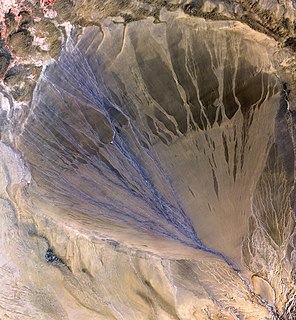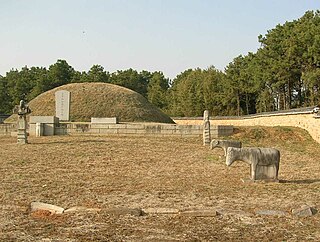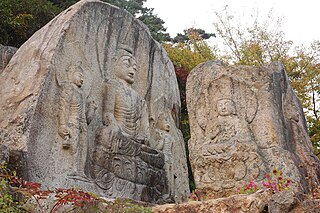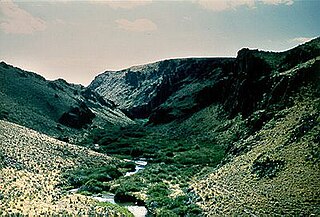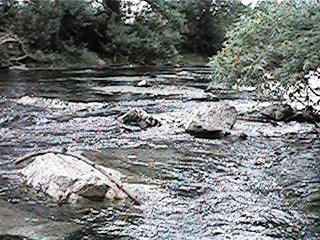| Gyeongju Basin | |
| Hangul | 경주분지 |
|---|---|
| Hanja | 慶 州 盆 地 |
| Revised Romanization | Gyeongju-bunji |
| McCune–Reischauer | Kyŏngju punji |
The Gyeongju Basin is a landform in Gyeongju city, North Gyeongsang province, South Korea. It forms part of the watershed of the Hyeongsan River, which flows north through the basin where it is joined by the Bukcheon, Namcheon, Daecheon, and Sogyeon-cheon streams.
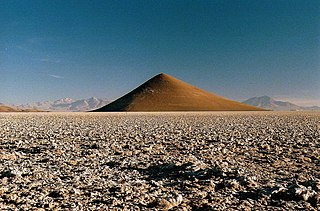
A landform is a natural feature of the solid surface of the Earth or other planetary body. Landforms together make up a given terrain, and their arrangement in the landscape is known as topography. Typical landforms include hills, mountains, plateaus, canyons, and valleys, as well as shoreline features such as bays, peninsulas, and seas, including submerged features such as mid-ocean ridges, volcanoes, and the great ocean basins.
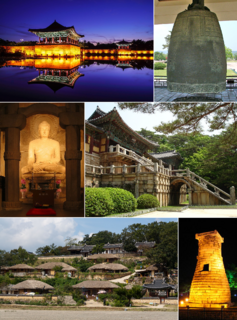
Gyeongju, historically known as Seorabeol, is a coastal city in the far southeastern corner of North Gyeongsang Province in South Korea. It is the second largest city by area in the province after Andong, covering 1,324 km2 (511 sq mi) with a population of 264,091 people Gyeongju is 370 km (230 mi) southeast of Seoul, and 55 km (34 mi) east of Daegu. The city borders Cheongdo and Yeongcheon to the west, Ulsan to the south and Pohang to the north, while to the east lies the coast of the Sea of Japan. Numerous low mountains—outliers of the Taebaek range—are scattered around the city.

South Korea, officially the Republic of Korea (ROK), is a country in East Asia, constituting the southern part of the Korean Peninsula and lying to the east of the Asian mainland. The name Korea is derived from Goguryeo which was one of the great powers in East Asia during its time, ruling most of the Korean Peninsula, Manchuria, parts of the Russian Far East and Inner Mongolia, under Gwanggaeto the Great. South Korea lies in the north temperate zone and has a predominantly mountainous terrain. It comprises an estimated 51.4 million residents distributed over 100,363 km2 (38,750 sq mi). Its capital and largest city is Seoul, with a population of around 10 million.
Contents
The basin is surrounded by low mountains, most of which are also part of Gyeongju National Park. Specifically, it is bordered by Gowi Mountain (495 m above sea level) on the south, Seondo Mountain (380 m) and Ongnyeo Peak (215 m) on the west, and Gumi Mountain (594 m) on the north. Namsan, a mountain composed of two peaks (466 m, 495 m), cuts the Gyeongju Basin into two parts at the southern end. The streams that flow from these mountains have formed a number of interlinked alluvial plains in the Basin.

A mountain is a large landform that rises above the surrounding land in a limited area, usually in the form of a peak. A mountain is generally steeper than a hill. Mountains are formed through tectonic forces or volcanism. These forces can locally raise the surface of the earth. Mountains erode slowly through the action of rivers, weather conditions, and glaciers. A few mountains are isolated summits, but most occur in huge mountain ranges.
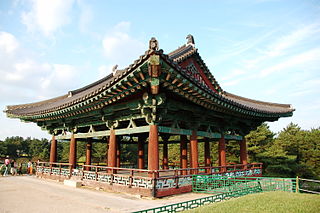
Gyeongju National Park is located in the province of Gyeongsangbuk-do, South Korea, and is the country's only historical national park. It was first designated a national park in 1968. The park covers many of the principal Silla historical sites in Gyeongju City. It is divided into several non-contiguous sections: Gumisan and Danseoksan sections to the west of the city center; Hwarang, Seo-ak, Sogeumgang, and Namsan sections in the heart of Gyeongju; Tohamsan section to the east, and Daebon section on the coast of the Sea of Japan.

Mean sea level (MSL) is an average level of the surface of one or more of Earth's oceans from which heights such as elevation may be measured. MSL is a type of vertical datum – a standardised geodetic datum – that is used, for example, as a chart datum in cartography and marine navigation, or, in aviation, as the standard sea level at which atmospheric pressure is measured to calibrate altitude and, consequently, aircraft flight levels. A common and relatively straightforward mean sea-level standard is the midpoint between a mean low and mean high tide at a particular location.
The city center of Gyeongju, which was also the capital of the ancient Silla kingdom, occupies much of the basin. Various watershed management projects were undertaken even during Silla times, due to continuous flooding in the basin, caused by runoff from the neighboring mountains combined with inflow from the upper Hyeongsan River watershed. The most recent severe flood took place in 1991.

Silla was a kingdom located in southern and central parts of the Korean Peninsula. Silla, along with Baekje and Goguryeo, formed the Three Kingdoms of Korea.

A flood is an overflow of water that submerges land that is usually dry. In the sense of "flowing water", the word may also be applied to the inflow of the tide. Floods are an area of study of the discipline hydrology and are of significant concern in agriculture, civil engineering and public health.
The basin is also home to a great number of important Korean cultural heritage assets, mostly related to its ancient role as capital of Silla. For example, the royal tombs of Silla are located there, as is the Gyerim forest. The slopes of the entire Namsan Mountain are covered in religious and ceremonial sites dating from the Mumun Pottery Period (c. 1500-300 B.C.) to the end of the Korean Three Kingdoms (c. AD 668). Namsan and environs is registered as a UNESCO World Heritage Site.
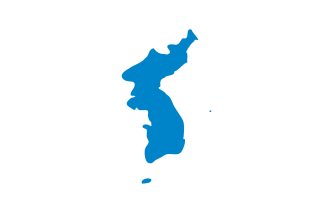
Korea is a region in East Asia. Since 1948, it has been divided between two distinct sovereign states: North Korea and South Korea. Korea consists of the Korean Peninsula, Jeju Island, and several minor islands near the peninsula. Korea is bordered by China to the northwest, Russia to the northeast, and neighbours Japan to the east by the Korea Strait and the Sea of Japan.
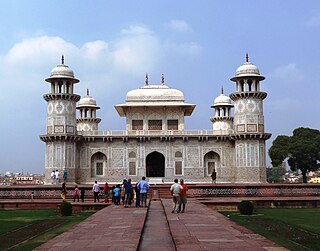
A tomb is a repository for the remains of the dead. It is generally any structurally enclosed interment space or burial chamber, of varying sizes.

A forest is a large area dominated by trees. Hundreds of more precise definitions of forest are used throughout the world, incorporating factors such as tree density, tree height, land use, legal standing and ecological function. According to the widely used Food and Agriculture Organization definition, forests covered 4 billion hectares (9.9×109 acres) (15 million square miles) or approximately 30 percent of the world's land area in 2006.
Agriculture is also undertaken on a significant scale within the basin. The crops are primary staples such as rice, barley, and soybeans. The Gyeongju strain of rice grown here is particularly famous for its quality. However, the Gyeongju Basin has undergone significant environmental strain since the 1970s resulting the construction of tourist facilities, the expansion and industrialization of urban Gyeongju, intensive agriculture, and the construction and use of national public infrastructure such as expressways, highways, and high-speed rail.

Agriculture is the science and art of cultivating plants and livestock. Agriculture was the key development in the rise of sedentary human civilization, whereby farming of domesticated species created food surpluses that enabled people to live in cities. The history of agriculture began thousands of years ago. After gathering wild grains beginning at least 105,000 years ago, nascent farmers began to plant them around 11,500 years ago. Pigs, sheep and cattle were domesticated over 10,000 years ago. Plants were independently cultivated in at least 11 regions of the world. Industrial agriculture based on large-scale monoculture in the twentieth century came to dominate agricultural output, though about 2 billion people still depended on subsistence agriculture into the twenty-first.
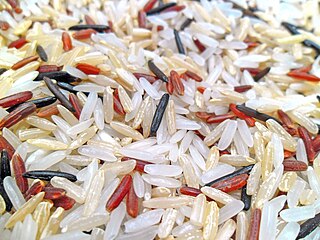
Rice is the seed of the grass species Oryza sativa or Oryza glaberrima. As a cereal grain, it is the most widely consumed staple food for a large part of the world's human population, especially in Asia. It is the agricultural commodity with the third-highest worldwide production, after sugarcane and maize.

Barley, a member of the grass family, is a major cereal grain grown in temperate climates globally. It was one of the first cultivated grains, particularly in Eurasia as early as 10,000 years ago. Barley has been used as animal fodder, as a source of fermentable material for beer and certain distilled beverages, and as a component of various health foods. It is used in soups and stews, and in barley bread of various cultures. Barley grains are commonly made into malt in a traditional and ancient method of preparation.


